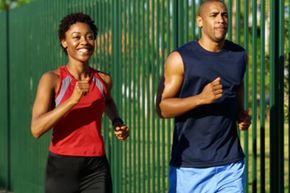As the story goes, famed cyclist Lance Armstrong not only beat cancer, but used it to his advantage. Following his near-miraculous survival of testicular cancer, in 1998 Armstrong returned to cycling with a vengeance. He had been a rising cycling star before the diagnosis, but now he seemed unstoppable. Had cancer transformed him into some sort of superman? In a sense, yes. Pre-cancer, Armstrong had been weighed down by several extra kilos of upper body mass. It wasn't fat -- he was just a muscular guy. Still, the extra weight was a burden, and since it was in the upper body, it didn't help him move the pedals any faster. On hill climbs Armstrong had been vulnerable to falling behind smaller, leaner cyclists. But now, Armstrong's post-chemotherapy emaciation was his new upper hand, and it was what helped propel him to seven consecutive Tour de France wins [source: Carmichael].
Armstrong's story is probably the most dramatic example of the importance of an effective power-to-weight ratio. In any endurance sport, success is determined not only by how much power an individual can generate, but also by how much weight he or she is carrying. Even if a 200-pound cyclist has a whopping 600 watts of pedaling power, he doesn't stand a chance against a 150-pound athlete who can do the same thing.
Advertisement
Huge, rippling muscles may look good at a bodybuilding competition, but they usually make for a poor endurance athlete. Look at a group of elite triathletes: Instead of a group of burly comic book figures, you're more likely to spot a line-up of lean, wiry physiques. Roger Bannister was a slender 6 feet 2 inches and 154 pounds when he ran the world's first four-minute mile [source: Sports Reference]. Paula Radcliffe -- the current world record holder for the women's marathon -- is a mere 5 feet 8 inches and 119 pounds [source: Paula Radcliffe].
Sculpting an effective power-to-weight ratio has become one of the final frontiers of endurance training. You can be strong, you can be fast, but if you're lugging around just a few more pounds than your equally powerful competitor, it could make the difference between success and failure.
Ultimately, the power-to-weight ratio is all about sculpting your body into the ideal machine for your particular sport. Any unneeded ounce of fat or muscle is burned off, leaving only those muscles that are needed to get you over the finish line. Of course, achieving this ideal body structure is a delicate dance. You want to cut calories and burn off pounds without sacrificing your overall performance. In this article, we'll look at how power-to-weight ratio is calculated, how it can affect your performance, and what you can do to improve it.
Keep reading to find out how to run more like a motorcycle.
Advertisement
